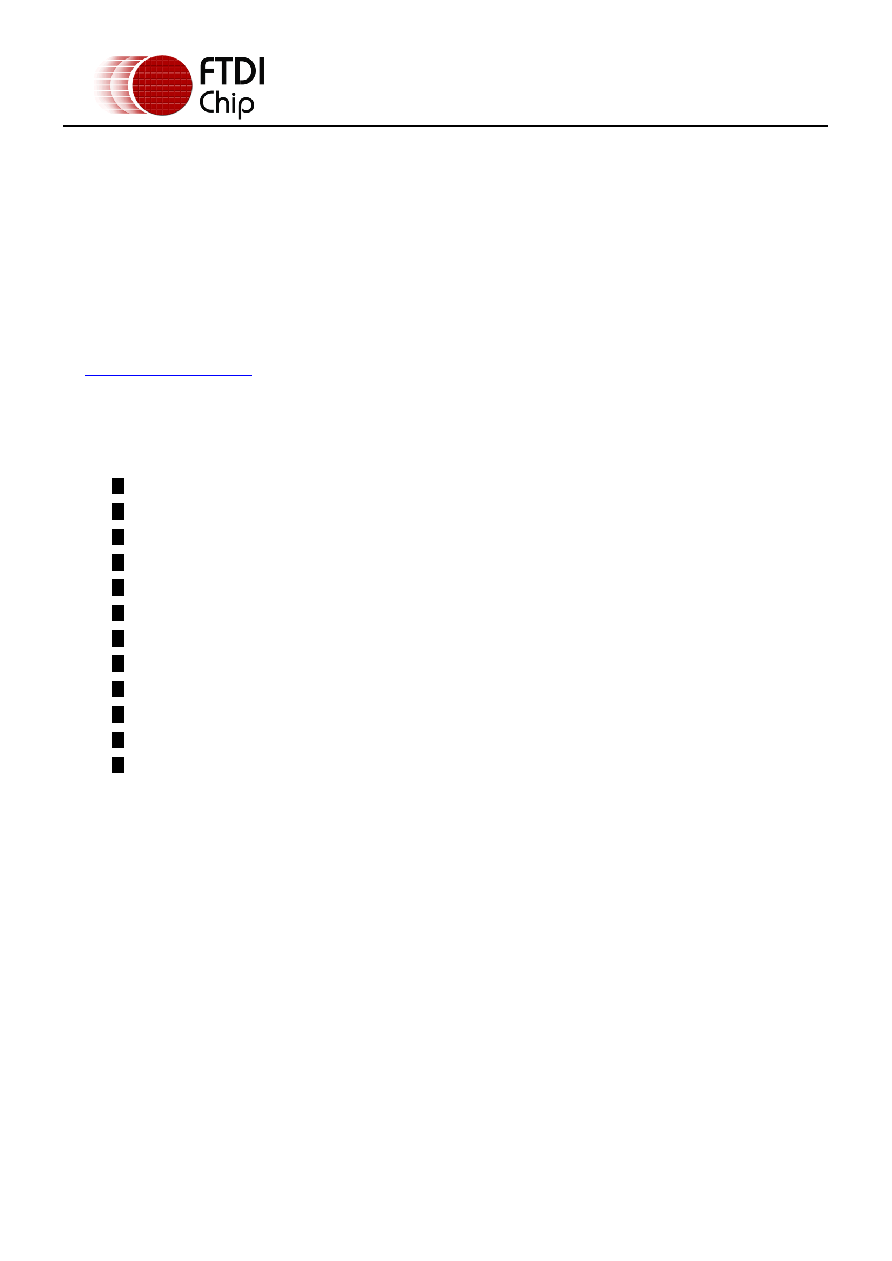- 您現(xiàn)在的位置:買賣IC網(wǎng) > PDF目錄202515 > VNC1L-1A (Future Technology Devices International Ltd) PDF資料下載
參數(shù)資料
| 型號: | VNC1L-1A |
| 廠商: | Future Technology Devices International Ltd |
| 元件分類: | 總線控制器 |
| 中文描述: | UNIVERSAL SERIAL BUS CONTROLLER, PQFP48 |
| 封裝: | 7 X 7 MM, 0.50 MM PITCH, GREEN, LQFP-48 |
| 文件頁數(shù): | 4/32頁 |
| 文件大小: | 672K |
| 代理商: | VNC1L-1A |
第1頁第2頁第3頁當(dāng)前第4頁第5頁第6頁第7頁第8頁第9頁第10頁第11頁第12頁第13頁第14頁第15頁第16頁第17頁第18頁第19頁第20頁第21頁第22頁第23頁第24頁第25頁第26頁第27頁第28頁第29頁第30頁第31頁第32頁

Copyright 2009 Future Technology Devices International Limited
12
Document Reference No.: FT_000030
Vinculum VNC1L Embedded USB Host Controller IC Datasheet Version 2.02
Clearance No.: FTDI# 50
4 Functional Description
The VNC1L is the first of FTDIs Vinculum family of Embedded USB host controller integrated circuit
devices. Vinculum can also encapsulate certain USB device classes handling the USB Host Interface and
data transfer functions using the in-built MCU and embedded Flash memory. When interfacing to mass
storage devices, such as USB Flash drives, Vinculum transparently handles the FAT File Structure using a
simple to implement command set. Vinculum provides a cost effective solution for introducing USB host
capability into products that previously did not have the hardware resources to do so.
The VNC1L has a Combined Interface which interfaces a controlling application with the Command
Monitor. The combined interfaces are UART, Parallel FIFO and SPI.
The VNC1L is supplied un-programmed. It can be programmed before assembly or it can be configured
“in the field” with configuration option firmware available from the Vinculum website at
4.1 Key Features
The VNC1L has the following key features:
Two independent USB Host ports.
8 or 32-bit V-MCU Core.
Dual DMA controllers for hardware acceleration.
64k Embedded Flash Program Memory.
4k internal Data SRAM.
2 x USB 2.0 Slow speed or Full speed Host or Slave ports.
Automatic Low or Full Speed selection.
UART, SPI and Parallel FIFO interfaces.
Up to 28 GPIO pins depending on configuration.
Low power operation (25mA running/2mA standby).
FTDI firmware easily updated in the field.
Multi-processor configuration capable.
4.2 Functional Block Descriptions
The following paragraphs detail each function within VNC1L. Please refer to the block diagram shown in
USB Transceivers 1 and 2 - The two USB transceiver cells provide the physical USB device interface
supporting USB 1.1 and USB 2.0 standards. Low-speed and full-speed USB data rates are supported.
Each output driver provides +3.3V level slew rate control signalling, whilst a differential receiver and two
single ended receivers provide USB DATA IN, SE0 and USB Reset condition detection. These cells also
include integrated internal USB pull-up or pull-down resistors as required for host or slave mode.
USB Serial Interface Engine (SIE) - These blocks handle the parallel to serial and serial to parallel
conversion of the USB physical layer. This includes bit stuffing packets, CRC generation, USB frame
generation and protocol error checking.
12 MHz Oscillator - The 12MHz Oscillator cell generates a 12MHz reference clock input to the Clock
Multiplier PLL from an external 12MHz crystal.
Clock Multiplier PLL - The Clock Multiplier PLL takes the 12MHz input from the Oscillator Cell and
generates 24MHz and 48MHz reference clock signals, which are required by the USB SIE Blocks, the MCU
core, System Timer and UART prescalar blocks.
Program and Test Logic - This block provides a means of programming the onboard E-FLASH memory.
When PROG# is pulled low and the device is reset by pulsing the #RESET low, the onboard E-FLASH
memory is bypassed by an internal hard-coded bootstrap Loader ROM which contains code to allow the E-
FLASH memory to be programmed via commands to the UART interface. FTDI provides a software utility
相關(guān)PDF資料 |
PDF描述 |
|---|---|
| VND5E012AYTR-E | SPECIALTY ANALOG CIRCUIT, PDSO36 |
| VNL5050S5-E | POWER SUPPLY SUPPORT CKT, PDSO8 |
| VNL5050N3TR-E | POWER SUPPLY SUPPORT CKT, PDSO3 |
| VO27.0000000M0000001 | VCXO, CLOCK, 27 MHz, TTL OUTPUT |
| VP06DDC1R0N999 | 0.3 W, SMPS TRANSFORMER |
相關(guān)代理商/技術(shù)參數(shù) |
參數(shù)描述 |
|---|---|
| VNC1L-1A-REEL | 功能描述:USB 接口集成電路 USB Vinculum Host /Dev Ctrl IC LQFP-48 RoHS:否 制造商:Cypress Semiconductor 產(chǎn)品:USB 2.0 數(shù)據(jù)速率: 接口類型:SPI 工作電源電壓:3.15 V to 3.45 V 工作電源電流: 最大工作溫度:+ 85 C 安裝風(fēng)格:SMD/SMT 封裝 / 箱體:WLCSP-20 |
| VNC1L-1A-TRAY | 功能描述:USB 接口集成電路 USB Vinculum Host /Dev Ctrl IC LQFP-48 RoHS:否 制造商:Cypress Semiconductor 產(chǎn)品:USB 2.0 數(shù)據(jù)速率: 接口類型:SPI 工作電源電壓:3.15 V to 3.45 V 工作電源電流: 最大工作溫度:+ 85 C 安裝風(fēng)格:SMD/SMT 封裝 / 箱體:WLCSP-20 |
| VNC2 | 制造商:FTDI 制造商全稱:FTDI 功能描述:VNC2 Debug Module |
| VNC2 DEBUG MODULE | 功能描述:界面開發(fā)工具 USB Vinculum-II Debug/Programmer Mod RoHS:否 制造商:Bourns 產(chǎn)品:Evaluation Boards 類型:RS-485 工具用于評估:ADM3485E 接口類型:RS-485 工作電源電壓:3.3 V |
| VNC214B-15A-1D | 制造商:SMC Corporation of America 功能描述:Valve, media, solenoid, body port, 1/2 inch |
發(fā)布緊急采購,3分鐘左右您將得到回復(fù)。